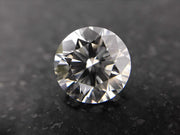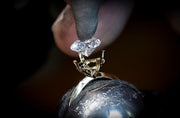Photo: Joshua Kissi
Annie Davidson, 2021
We’re talking diamonds made out of thin air, literally.
The word sustainability carries a lot of weight, yet its meaning can’t be summed up under one textbook definition. It’s a hypernym under which many other words, interpretations, and practices fall. Take one fashion designer, for example, who believes that there is no perfect sustainable material. Others believe that sustainability doesn’t end at the product, but should be practiced holistically from manufacturing through packaging. What all these designers can agree on, however, is that making the effort to be more sustainable, whatever that means to them, is important. Here are a few of the most innovative materials designers are working with that have allowed them to create while thinking of the effect on the planet first and foremost.
BELEAF
BeLeaf is a sustainable Brazilian elephant-ear leaf which handbag designer Amélie Pichard uses in lieu of leather. For Pichard, who also experiments with materials like pineapple leaf and Mexican cactus fiber, BeLeaf is the most uncommon because it arrives in one piece, in the shape of a leaf, with veins intact. When working with the material, “we have to figure out how to cut to have the best drawing of veins,” she says. “This is not the designer’s choice, it is the leaf’s choice! And I love that! I love restriction, and especially when it is nature that is dominating me. Each bag will be different and made according to each leaf.”
WINE GRAPES
While Mirco Scoccia is experimenting with many sustainable materials for his new vegan shoe brand O2 Monde—including pineapple leaf, a corn-and-cereal concoction, wood, and more—the most uncommon is called Vitigna, or used wine grapes. Crafted exclusively from wine industry leftovers, this “wine leather” is both eco-friendly and vegan, coming straight from Tuscany’s famous vineyards. “I’m committed to creating luxury, sustainable shoes in a vegan and clean way,” Scoccia says. “To achieve my goal, I’ve been researching a lot, and I reached out to hundreds of vendors even from different categories (including furniture and cars for wood). I wanted to use plant-based materials and also work with traditional Italian manufacturers.” And for this designer, sustainability goes beyond the grapes: “To me, it’s not only about making beautiful vegan shoes, but also making sure the entire supply chain will respect certain higher standards in respect of eco-sustainable practices.”
“We definitely feel we are bringing positive change to the world,” says House of Fluff’s founder and creative director, Kym Canter. “In our case, we are not just bringing a better blouse or skirt into the world, we are helping people understand there are alternatives to using animal products, that the world has evolved and that killing animals is an unnecessary evil in today’s society. We feel every one of our products offers a legitimate and better alternative to what came before.” For Canter, better products come from smart swaps of materials like cactus as opposed to leather. But the success of products is not limited to the materials. To keep their carbon footprint low, for example, House of Fluff had to source cactus leather from manufacturers nearby the farm in Mexico. “To be truly sustainable, you need to think about every facet of production and design, including carbon footprint, water use, even workers.”
CARBON
Among the never-ending diamond debate is Aether, in a category of its own: diamonds made from excess carbon in the atmosphere. That means that these diamonds are not only sustainable, but they actually help improve the environment. The process involves direct air-capture technology that pulls carbon dioxide and other compounds from the atmosphere, where the carbon dioxide gets collected in a specialized filter that isolates the carbon. It is then turned into usable raw material for growing diamonds in reactors. “We also have a mantra in our company that we can’t make real change in the world by simply having ‘zero impact,’” says chief marketing officer Robert Hagemann. “That’s why our diamonds aren’t carbon-neutral, they’re carbon-negative—we actually remove carbon pollution from the atmosphere with every single diamond we create. If we as a species have spent centuries polluting and damaging our planet, it’s going to take a lot more than just being neutral to reverse that impact.”
RECYCLED FIBERS
Using fibers from recycled materials, Paradis Perdus is known for making 100 percent recycled knitwear. The yarns are created from discarded sweaters that are taken apart, filtered by color, and spun into new fiber. And with more restrictions also come more opportunities for the brand. “While I used to be offered around 2,000–2,500 different yarns at the yarn fair in Italy, today I can only choose from 10–12 different yarns,” says co-founder Thomas Poli. “So we have to be creative in different ways! We use different yarn plies, stitches, jacquard, and intarsia to bring fantasy with the yarns that we have available.” The next challenge for the brand is creating buttons from used eyeglass frames and experimenting with ways to make zippers.
ROSE SYLK
Collina Strada designer Hillary Taymor creates clothing from 100 percent rose sylk, which is a cellulose fiber made from the natural waste of rose bushes and stems. While she has faced her fair share of challenges with the material (like the final product being somewhat different from what is shown on the runway), Taymour is determined to continue working with sustainable materials and helping the planet. “I should note that all brands need to step up their game in their sustainability practices—it’s the only thing we can do,” she says.







